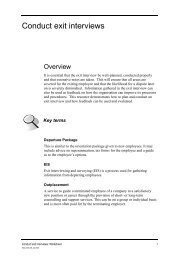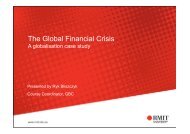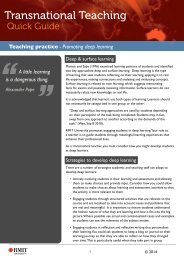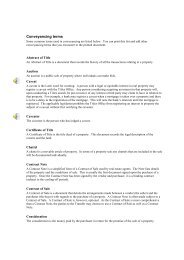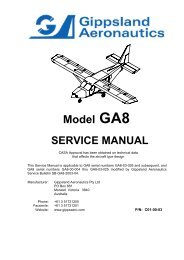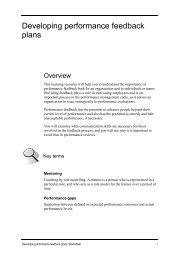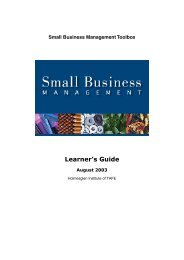Minimise conflict worksheet - PDF - Flexible Learning Toolboxes
Minimise conflict worksheet - PDF - Flexible Learning Toolboxes
Minimise conflict worksheet - PDF - Flexible Learning Toolboxes
You also want an ePaper? Increase the reach of your titles
YUMPU automatically turns print PDFs into web optimized ePapers that Google loves.
<strong>Minimise</strong> <strong>conflict</strong> in industrial relationsOverviewIt is almost inevitable that <strong>conflict</strong> will arise in workplaces, over the mosttrivial to most difficult and challenging issues. Such <strong>conflict</strong> can beminimised by creating an environment where communication is encouragedand grievance procedures exist, are utilised and respected. It is important tohave effective communication throughout the organisation and to monitorthe workplace so that potential <strong>conflict</strong> is more quickly identified andresolved. Such strategies can help to avoid dissatisfaction and low moralewhich often underlie <strong>conflict</strong>.Key termsGrievance procedureA formal procedure that enables employees to know when and how to airtheir grievances.Workplace cultureThe shared values and beliefs of the employees within a particularworkplace.Industrial <strong>conflict</strong>Employers and employees often have different objectives, and inevitablythis may cause <strong>conflict</strong> in the workplace. However, steps can be taken toreduce this potential by developing a culture where communication isencouraged between the organisation’s management team and employees.<strong>Minimise</strong> <strong>conflict</strong>: Worksheet 12002_329_032 July 2003
Types of industrial <strong>conflict</strong>Industrial actionStrikes are the most visible form of <strong>conflict</strong> and create the most impact. TheAustralian Workplace Relations Act 1996 recognises the legitimacy ofindustrial action during the course of enterprise negotiations. In thisinstance, industrial action includes any worker activity that restricts ordelays work, such as:• bans, where employees decide not to perform certain activities• work-to-rule, where employees only perform the tasks that are statedwithin their job description• go-slow campaigns, where employees dramatically slow down the paceof their work.AbsenteeismThe most common way employees respond to unsatisfactory workingconditions or a stressful work environment is through absenteeism. A highlevel of absenteeism can cost the organisation significantly. The two typesof absenteeism are:1. involuntary absenteeism, mostly due to illness2. voluntary absenteeism, which may be due to a variety of reasons such asthe individual’s attitude to work, their personal level of job satisfactionor organisational issues, such as stress, <strong>conflict</strong>, and the nature of theirwork.Labour turnoverAbsenteeism and labour turnover are related, as they are both forms ofwithdrawal from the organisation. Absenteeism is a temporary withdrawalwhile turnover is permanent. Often a person’s dissatisfaction with his or herjob begins with absenteeism, which progresses over time, combined with anincreasing sense of dissatisfaction, resulting in a decision to leave thatcompany.Strategies to address industrial <strong>conflict</strong>Strategies to address industrial actionStrategies to reduce industrial action include:• developing a culture that encourages communication betweenemployers and employees• developing a formal, trusted grievance policy to help quickly identifygrievances and potential sources of <strong>conflict</strong>2 <strong>Minimise</strong> <strong>conflict</strong>: Worksheet2002_329_032 July 2003
• developing a more positive relationship between employers, employeesand their respective unions.Strategies to address absenteeismStrategies to manage absenteeism include:• allowing supervisors more flexibility and discretion in the absence ofmanagement• providing opportunities to employees to multiskill or job enlarge• providing opportunities for employee participation in areas such asdecision-making, fair treatment and job security• improving communication between employers and employees so thatemployees understand the tasks they are expected to do at work• providing employees with a career path and promotional opportunities• improving the relationship between management, unions andemployees.Strategies to address labour turnoverStrategies that employers can use to manage labour turnover include:1. encouraging organisational commitment through the use of reward andrecognition programs, career paths and reducing work-related stresses2. providing applicants at their interview with a clear idea of what the jobwill involve3. initiating methods to improve the level of job satisfaction through, forexample, multi-skilling and job enrichment4. providing competitive wages and benefits packages.Ideally, for performance gaps to be closed, the concept of mutualcommitment needs to be implemented.ThinkWithin the organisation for which you currently work, or one for which youhave been previously employed, think of the methods that employees use toexpress their dissatisfaction with their job.<strong>Minimise</strong> <strong>conflict</strong>: Worksheet 32002_329_032 July 2003
Mutual Commitment practicesMutual Commitment is another strategy that can help to eliminate industrialrelations issues within the workplace.This strategy is aimed at three areas:1. recruitment – the organisation aims to attract highly committed, flexibleemployees2. internal culture – rewards commitment and training with promotion andjob security3. internal communication – constant improvement through methods suchas team briefings.The underlying reasoning for this practice is to recognise the needs of theemployee, leading to their increased commitment to the organisation, whichenables the organisation to achieve its objectives.High Commitment practices include:• career ladders and progression available to all employees• long-term training budgets• a system of teamwork• flexible job descriptions• jobs designed to utilise a full range of employee skills and abilities.Monitoring the workplace to minimisedysfunctional <strong>conflict</strong>There are many potential causes of <strong>conflict</strong> or grievance withinorganisations. These include those relating to the Certified Agreement orAustralian Workplace Agreement.In most industrial relations implementation plans, organisations addressindustrial issues that are likely to cause <strong>conflict</strong>s or grievances within thatcompany. For example, many implementation plans concentrate on issuessuch as multi-skilling, job enhancement and career progression. Under therequirements of the Australian Workplace Relations Act 1996, organisationsmust establish a formal grievance policy. The emphasis of the Act is forworkplaces to resolve their grievances internally; however, the AIRC isusually sourced in cases of industrial action.Strategies to monitor the workplace so that <strong>conflict</strong> can be identified andresolved quickly include:• formal grievance policies and procedures• effective communication channels• effective relationships between employers and employees• training and professional development for supervisors in effective<strong>conflict</strong> resolution techniques.4 <strong>Minimise</strong> <strong>conflict</strong>: Worksheet2002_329_032 July 2003
Formal grievance policies and proceduresTo be effective, formal grievance policies must be supported by bothemployers and employees. They must resolve grievances within a specifiedtime period, and all grievances must be taken seriously. Matters must bedealt with in strict confidentiality and supervisors should be trained in this.Effective communication channelsA variety of approaches can be taken to improve communication channels.These include:• regular formal staff meetings• an ‘open door’ policy, where all employees are confident that they canapproach senior managers at any time• providing information to all employees on the latest happenings withintheir workplace (eg via a newsletter given out with pay slips, or acompany website).Effective relationships between employers andemployeesCreating effective relationships between employers and employees is acomplex area and may require changing the corporate culture of anorganisation.The idea is to improve relationships so that:• <strong>conflict</strong>s or grievances can be more easily discussed• employees feel more comfortable approaching their supervisor oranother supervisor about issues of concern• employers are more easily able to identify potential sources of <strong>conflict</strong>or grievance• morale among workers increases.Training and professional development for supervisorsin effective <strong>conflict</strong> resolution techniquesConflict resolution is an important skill in today’s industrial relationsenvironment. The focus is now to resolve issues within the workplace, withreferral to outside agencies, such as the Australian Industrial RelationsCommission (AIRC), only taking place in extreme circumstances.Think<strong>Minimise</strong> <strong>conflict</strong>: Worksheet 52002_329_032 July 2003
Remember a time when there was potential for <strong>conflict</strong> in your workplace.What were the reasons for this and how was it resolved? Was there anythingyou think could have been done differently?Reviewing <strong>conflict</strong> managementproceduresIt is important to regularly review your organisation’s <strong>conflict</strong> managementprocedures.Timing of reviewsAfter a <strong>conflict</strong> has been resolvedMost managers will review their company’s procedures after they have beenused to resolve a <strong>conflict</strong>.Areas to be examined will include:• the level of effectiveness of their policy• the clarity of wording – was the policy easy to understand and interpret?• accessibility – was the policy easily accessed by both employers andemployees?• timing – was there a time limit given for each of the steps involved inthe <strong>conflict</strong> procedures?• expertise – did the organisation have experts available in the area of<strong>conflict</strong> management?• the level of training provided to managers on <strong>conflict</strong> resolution – doesthe organisation need to update these skills or provide additionaltraining (eg mediation skills).New or renewed agreementsThe other occasion when <strong>conflict</strong> management procedures may be evaluatedis when agreements are being drafted or renewed. During this time, allparties involved (ie employee(s), union(s) and employers) may wish toexamine the <strong>conflict</strong> management procedures to ensure that they meet theirneeds.6 <strong>Minimise</strong> <strong>conflict</strong>: Worksheet2002_329_032 July 2003
Senior management supportIt is important that the <strong>conflict</strong> management procedures developed and usedwithin the organisation have the full support of the senior managementteam. They must be seen to be proactive in the area of ensuring that allgrievances or <strong>conflict</strong>s are dealt with seriously by a trained staff member.The senior management team must lead the way by providing all of theirstaff, not just the managers, with opportunities to access training andprofessional development in <strong>conflict</strong> resolution procedures.It is essential that the <strong>conflict</strong> management procedures are clearlycommunicated to all staff as part of the overall procedure ofimplementation. The executive officer should, if possible, be the person tocommunicate these new policies as part of the overall improvements madeto the organisation’s industrial relations policies and procedures.It should be portrayed to all staff as a positive measure. They should also bemade aware of how they can access these policies both in their inductionand through regular communications, such as via written statements givento all staff with their pay slips, articles in a newsletter or through theorganisation’s website.Union involvementOften, when compiling the organisation’s <strong>conflict</strong> management procedures,the involvement of the unions in either drafting the procedure or reviewinga working draft may ensure that they support the <strong>conflict</strong> managementprocess and help to ensure a future positive working relationship.Legal issuesThe legal requirements of all procedures need to be examined by thecompany’s legal representatives to ensure that they will stand up to closescrutiny, should an issue be taken to either the AIRC or court.<strong>Minimise</strong> <strong>conflict</strong>: Worksheet 72002_329_032 July 2003
ThinkIn you own workplace, how do employees receive information about suchthings as <strong>conflict</strong> management or grievance procedures?How are you kept informed about changes and developments in theorganisation?Could the manner of communication within the organisation be improvedand if so, how?Parts of this resource are adapted from Open <strong>Learning</strong> Institute (2003)Learner's Guide BSBHR504A TAFE QLD; used with permission.8 <strong>Minimise</strong> <strong>conflict</strong>: Worksheet2002_329_032 July 2003




